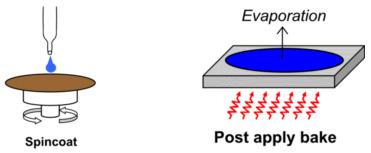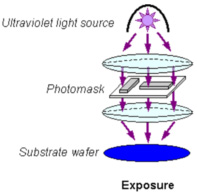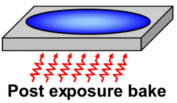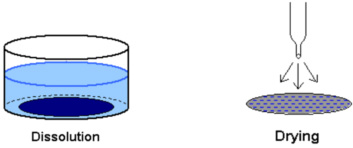Photolithography Process Flow
Please click on the links below for more information on resist modeling techniques.1. Film Creation
The first step is formation of a photoresist film on the substrate
wafer. First, the wafer is coated with a thin layer of photoresist via a
spincoating process. In spincoating, the liquid photoresist solution is
first dispensed onto the wafer, and the wafer is then spun rapidly. The
result is a thin, uniform film over the surface of the wafer. The wafer
is then placed on a hotplate to evaporate most of the solvent from the
film so that a dense solid film is formed. This first baking step is
often called the prebake or the post apply bake (PAB).

2. Exposure
The second step is exposure of the film. During exposure, ultraviolet light passes through a photomask into the photoresist film. This ultraviolet radiation is absorbed by the film and causes a chemical reaction that alters the film composition in the exposed regions. In many classes of photoresists, exposure to ultraviolet radiation results in the generation of acid molecules within the film. These acid molecules will later catalyze a reaction that alters the solubility of the film in exposed regions.
3. Post Exposure Bake
In the third step, the film is baked again. During this bake (termed the post exposure bake, or PEB), the acid molecules that were generated during exposure react with the polymer and change the chemical structure of the polymer. The result of this reaction is that the solubility of the film is now very different in the exposed and unexposed regions of the film. The catalytic nature of this reaction is termed “chemical amplification”. Chemically amplified resists require much less exposure dose because a single photoproduct can catalyze many solubility-switching reactions. This is very desirable because it increases the throughput of the exposure process.
4. Development
In the last step, the substrate is immersed in liquid developer. Many photoresists are based upon acidic polymers; these resists are developed in an aqueous base solution. In the exposed regions, the film is very soluble and is quickly removed. In the unexposed region, the dissolution rate is much lower and the film remains. The end result of the entire process is that the pattern from the photomask has been transferred into a three dimensional topography of photoresist.
Next: Film Creation Module
